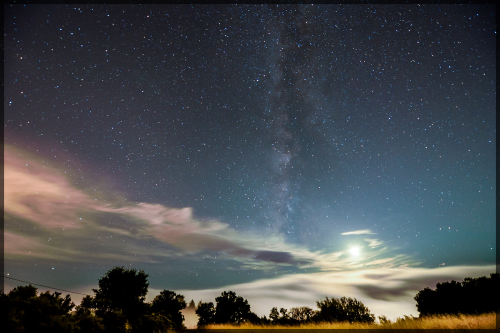
Firstly, yes we know this is a terrible photo. It’s not supposed to be the best Milkyway you’ve ever seen. It was taken as a test shot for the new Nikon D750.
Let’s start by talking about what you know about the Milkway. We’re guessing there’s 3 basic things. Firstly, its hard to spot with the naked eye. Secondly, you can’t see it over a city because of light pollution. And finally, you can’t see it on a moonlit night, again because of all that extra light bouncing around.
Well, you’re wrong. The above (terrible) picture was taken over Silicon Valley, home to over 2.9 million people, most of whom like well-lit streets and night-lights. And see that bright spot in the lower right quadrant of the photo? That’s the moon, beaming back the sun’s rays from just less than 50% of its surface. That’s a waxing crescent moon to you pros.
So how did we take such an impossible picture? Firstly we drove through thick fog looking for a clear break. That’s the white stuff over the trees in the picture. It’s not low cloud, it’s soupy fog. We love that kind of thing here in the valley. Next we used the new Nikon D750. As you know, we take a lot of night photos here at ScaresMe, and our normal camera (the Nikon D300) can’t take anything over ISO500 without requiring extensive noise reduction. The new D750 claims to be able to take 3 stops over 12,800. But can it really?
Let’s see.
Firstly, some mumbo jumbo about what you’re looking at. The camera was set to take 14bit RAW files, with high ISO noise reduction on. The lens is the startling Nikon 14-24mm f2.8 set at 14mm. The image duration was a lazy 30 seconds. White balance was set to cloudy, not that that makes any difference. The RAW files can’t yet be processed in Photoshop so we had to load them in to Nikon’s own image editing software. Assuming that the program does no auto-processing of the files (that’s our guess), we simply saved them as TIFF documents. At this point they’re 14bit files measuring a whopping 6016 pixels by 4016 with 300ppi. Those files are simply too huge to upload in to WordPress.
Here’s the processing steps we took so you can view the files. We loaded the TIFF files in to Photoshop. We selected an area of the trees using the marquee tool, copied it, and pasted it to a new layer. We then used the transform tool to enlarge the area to something massive. We then used the image resize tool, with resampling set to auto, to make the photo a more manageable size. Then we added the type. And finally, we saved it as JPEG with a quality setting of 9 (same as all the photos on this site). That resulted in a bunch of files that are 8bit, 300ppi, 1618×1080. They’re not exactly ‘straight from the camera’ but they’ve not had any post processing done.
The reason we did all this was to see just how much noise is in Nikon D750 photo when used at startlingly high ISO.
Here’s the first picture at the lowest ISO setting of 100. The camera can see a little less than the human eye at this setting. If you look hard in the white ellipse you’ll see the blown up trees and some fog. There’s almost no noise.
 At ISO640, (the highest we ever took the D300) there’s a little noise but nothing we can’t cope with. The image is a little brighter than the human eye perceived the scene.
At ISO640, (the highest we ever took the D300) there’s a little noise but nothing we can’t cope with. The image is a little brighter than the human eye perceived the scene.
Now at ISO1600, and the camera has turned the scene into daylight. There’s almost no noise but then we assume in-camera noise reduction has kicked in. With the D300 this function made very little difference. Here it seems to work flawlessly.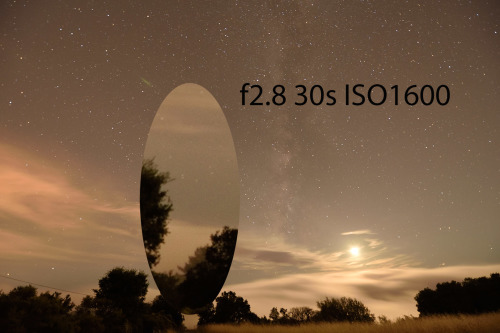
At ISO3200 it’s now a bright summers day, even though the clock is showing it’s 11pm at night. There’s still no noise in the picture.
We’re now at ISO6400 and it’s stupidly bright. The camera is grabbing so much light we think we can spot birds sleeping in the trees. Still no noise.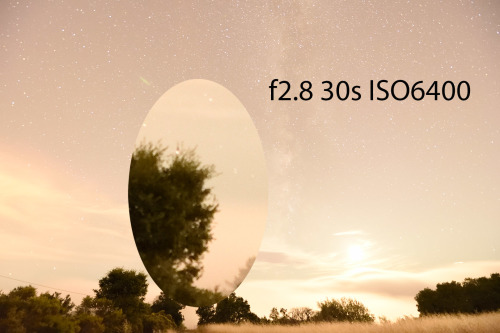
At ISO8000, and there’s no sign the camera is ever going to stop.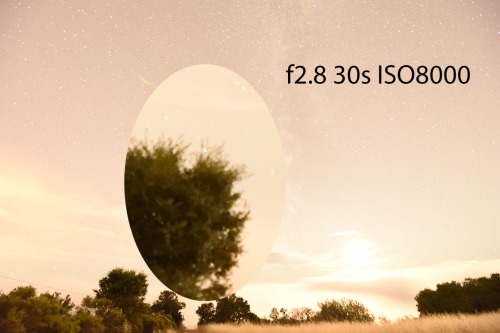
There’s nothing more to say about ISO10000 either. It’s just an over exposed photo with no noise.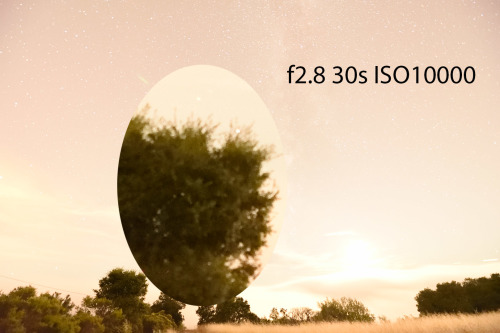
And finally, at the highest listed ISO 12,800 there’s very little usable data in the image because it’s so over exposed. But again, almost no noise.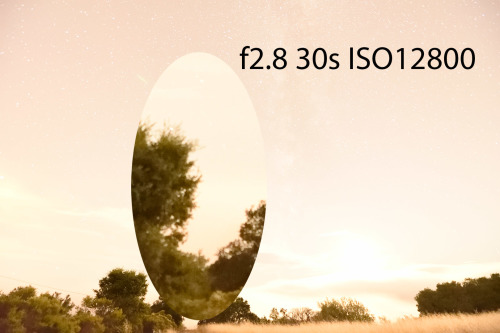
The camera actually has 3 settings higher than this but we’ve not yet tried them. The fact that Nikon choose to call then H1, H2 and H3 suggests that the camera is doing something bizarre that doesn’t really map to the ISO measuring system. One day we’ll use them, but for now we’ll stop at 12,800.
So back to the photo that started all this, the one at the top (and repeated below). This is the ISO1600 image, processed in camera raw, white balance fixed, contrast applied. And there you can see the Milkyway, captured next to the waxing crescent moon, on a night when 2.9 million people we’re sleeping less than 10 miles away. This camera is freakin awesome. It can see in the dark.
Just for giggles, we took 5 of the images and processed them in Photomatix, our HDR software of choice. The image below is no better than the single shot version except it doesn’t have the nasty coloring of the clouds. It does have the stars turning in to little dashes rather than pinpricks which is annoying but hey, this is just a test, not a gallery entry.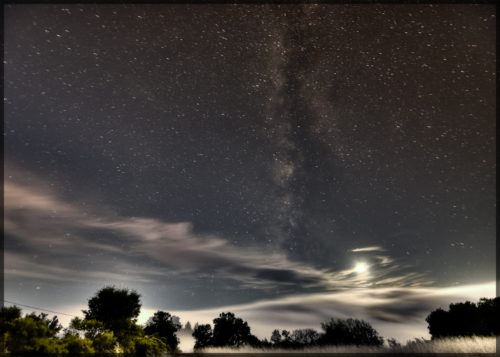
Other things you should know about the Nikon D750
- ergonomically it’s superb. Smaller and much lighter than the D300, with really nice button placement and functions.
- ‘they’ claim it can focus in up to -3EV. That’s the dark to you and me. We couldn’t get that to work. But as you saw in the above pictures, it was really really dark so we’ll keep trying.
- the only negative about the camera is that it takes an extraordinary long time to switch from shooting mode to programming mode. If you want to enter the menu system or review a photo, the switching of modes takes about 2 seconds. That doesn’t seem like a lot until you remember that your Apple products are designed to respond to a request in less than a ⅓ of a second. The d300 was instant too. Seems odd they’d have slowed it down.
Anyway, that’s our impression of the D750. It’s amazing. It can see in the dark.
UPDATE: It can focus in the dark too
Hello again. In the above we mentioned that the camera failed to focus in the absolute dark of a late evening sky. That’s hardly surprising really: we were having trouble seeing where we were walking ourselves. Since we wrote that, we’ve had chance to hang around in the dark a bit more, and our unscientific tests show the camera is superb.
Take a look at this picture http://photoshopscaresme.com/tutorial-capturing-lunar-eclipse/. The foreground in that image was taken at f7, ISO500, 24mm using the amazing 14-24 f2.8 nikon glass. It was a full moon (obviously) and the Temple was well lit, but we’re pretty sure our D300 couldn’t have focused on it. And a couple of people using other cameras were having to focus on well lit windows and then re-frame their images. Not so the D750; point and shoot. The 6 images that make up the foreground were all captured without incident. In fact, we captured a bunch of images hand-held using f2.8 and auto ISO, that show perfect focus and very low noise.
We repeat. This camera can see in the dark
Thanks for stopping by.
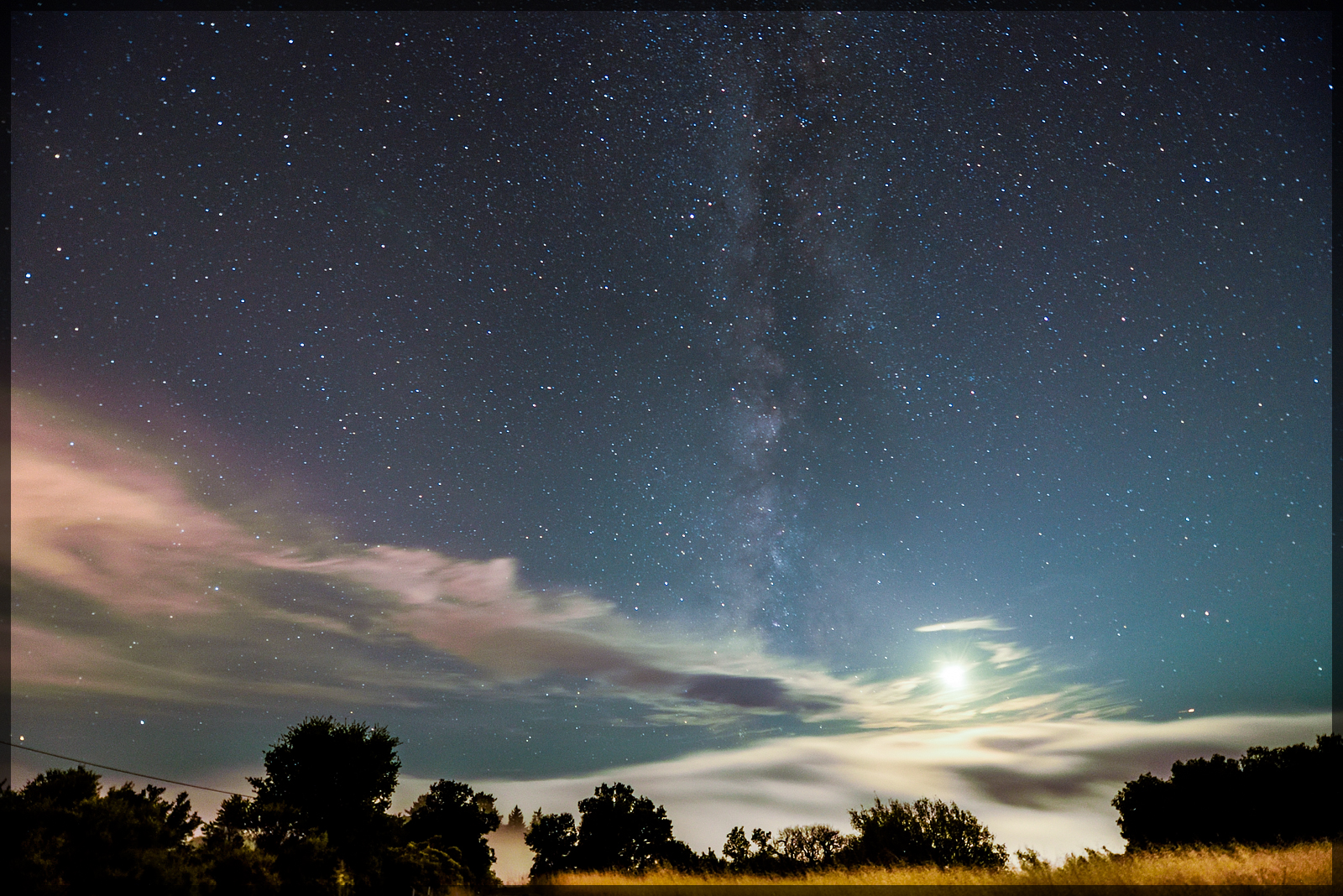
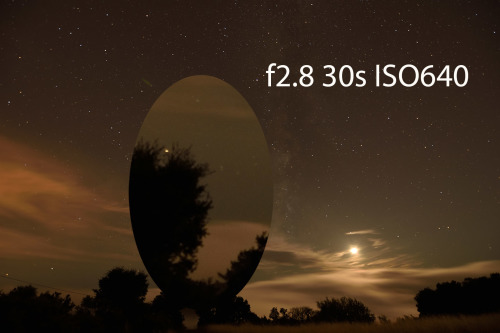
Come on, talk to us!